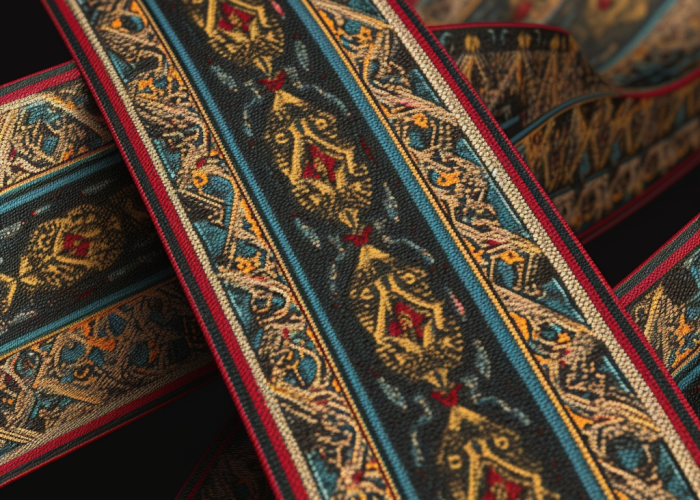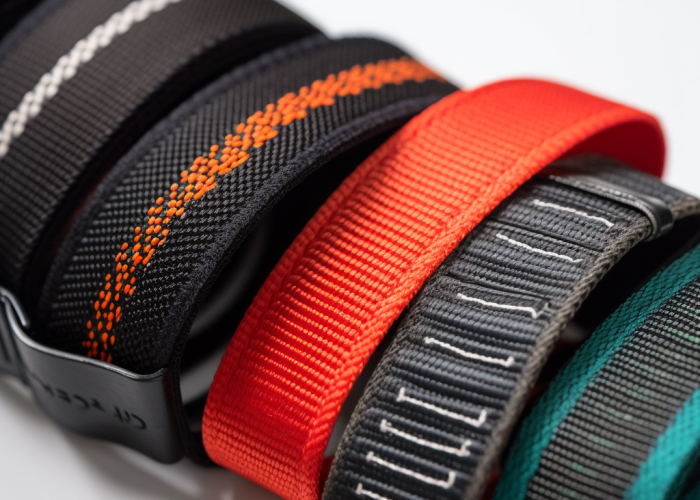Through years of manufacturing custom jacquard webbing for leading brands, we’ve perfected the integration of complex logos and intricate patterns into durable, professional-grade webbing. Our technical expertise in jacquard weaving technology enables us to transform your brand identity into high-performance webbing that maintains design integrity under demanding conditions.
Jacquard webbing customization weaves your logo directly into the fabric structure using computerized looms, creating permanent branding that won’t fade, peel, or wear off like printed alternatives.
Discover how to optimize logo clarity, choose the right materials, and meet quality standards for high-performance, custom-branded webbing solutions.


Webbing manufacturing expert with 15+ years of experience helping product developers build high-performance straps for industrial, medical, and outdoor use.
Jacquard webbing offers superior durability and brand permanence by weaving patterns directly into the fabric, unlike printed designs that sit on the surface and degrade over time. This construction ensures logos stay intact through repeated use, maintaining brand integrity even under heavy flexing and sunlight exposure.
Comparative testing shows jacquard retains 100% pattern integrity after 10,000 flex cycles, while printed webbing cracks or peels by 3,000–5,000 cycles. Jacquard also achieves Grade 4–5 colorfastness under AATCC 16 lightfastness testing, compared to Grade 2–3 for printed designs. After 1,000 hours of UV exposure, jacquard retains 95% color accuracy, while printed versions fade by 20–40%.
From our manufacturing experience, brands using jacquard webbing in outdoor gear, luggage, and pet products report significantly fewer issues related to logo wear or fading. While jacquard involves higher upfront costs, the long-term value becomes evident through reduced warranty claims and sustained brand presentation throughout product lifecycles. Jacquard meets OEKO-TEX Standard 100 safety standards and complies with UV resistance benchmarks for commercial use.
Key Takeaways: Jacquard vs Printed Webbing
Jacquard webbing is constrained by weave resolution, color count, and pattern complexity, which limits its ability to replicate fine details, gradients, or small text. Designs must account for minimum feature sizes (≥0.8mm), limited color threads (max 6–8), and pattern repeats constrained by webbing width.
From our experience, the most common design failures come from logos with intricate details or subtle gradients that blur or pixelate when woven. For best results, simplify your artwork with bold lines, high contrast, and clean shapes optimized for the physical limitations of the jacquard loom.
Key Limitations Summary:

Jacquard logos should be submitted in vector format (AI, EPS, PDF) with simplified color schemes, clear outlines, and proper scaling for webbing dimensions. Files must avoid gradients, soft edges, or complex font treatments to ensure accurate pattern weaving.
Production-ready files require all text converted to outlines, color definitions in Pantone or CMYK, and multiple orientation versions for layout flexibility. We recommend preparing a “jacquard-optimized” version of your logo tailored to the medium, not just reusing your digital or print logo directly.
File Prep Summary:
Polyester offers the best overall performance for custom jacquard webbing, providing superior color retention, durability, and design clarity compared to nylon, polypropylene, or cotton alternatives. The material choice directly impacts logo appearance, longevity, and application suitability.
Performance comparisons show polyester achieves sharper pattern definition with 8-10% less stretch than nylon, ensuring logos maintain proper proportions during use. Nylon offers superior abrasion resistance, making it ideal for high-wear applications like bag straps and handles. Cotton provides cost-effectiveness and natural feel but absorbs moisture readily and requires treatment for outdoor durability. Polypropylene offers the lowest material cost but limits design complexity due to lower melting point constraints during weaving.
From our manufacturing experience, polyester consistently delivers the best balance of durability, design clarity, and cost-effectiveness across diverse applications. Nylon works excellently for indoor heavy-duty applications where abrasion resistance is critical. For eco-conscious brands, organic cotton and recycled polyester options are available, though they may require additional treatments for moisture resistance. Cost considerations typically show polyester at mid-range pricing, with polypropylene being most economical and nylon commanding premium pricing.
Material Performance Comparison:

Custom jacquard webbing must comply with OEKO-TEX Standard 100 for consumer safety, plus application-specific standards like CPSIA for children’s products or automotive specifications for vehicle applications. Compliance ensures legal market access and product safety.
Key testing requirements include restricted substance testing under OEKO-TEX Standard 100, which limits harmful chemicals to levels safe for direct skin contact. Children’s products require CPSIA compliance with lead content below 100 ppm and specific phthalate restrictions. Automotive applications demand flame retardancy per FMVSS 302 and UV resistance testing under ASTM G155 protocols. Breaking strength testing follows ASTM D5034 or ISO 13934 standards depending on target markets and load requirements.
From our quality assurance experience, retail brands prioritize OEKO-TEX certification for consumer confidence, while industrial clients focus on performance standards like tensile strength specifications. Early standard identification prevents costly re-testing and production delays—we recommend determining compliance requirements during the design phase. European markets require REACH compliance for chemical restrictions, while North American markets emphasize CPSIA for consumer goods. Ensure documentation such as test reports and batch traceability is available for audits and regulatory compliance verification.
Essential Standards by Application:
Ordering samples reduces production risk by allowing you to verify design accuracy, color matching, and material quality before committing to a full run. It helps catch potential issues that digital proofs can’t show—such as actual thread tension effects, color shifts under different lighting, and the webbing’s hand-feel.
Typical sampling costs range from $50–200 per variation, with lead times of 7–10 business days. This small investment helps avoid costly mistakes and production delays. From our experience, skipping samples often leads to 30–40% higher revision rates, delayed shipments, and unexpected failures in pattern resolution or material performance.
Sampling Benefits:

Minimum order quantity (MOQ) typically ranges from 1,000–5,000 meters depending on design complexity. This is due to loom setup costs, color matching, and material prep, which are spread across the total production volume.
Setup fees include $200–500 for loom programming and $50–100 per color for dye matching. Small runs (<1,000m) carry higher unit pricing due to fixed setup costs, while large runs benefit from volume efficiency. Lead times range from 2–3 weeks standard to 4–6 weeks for peak seasons or complex designs.
MOQ & Pricing Structure:

Jacquard webbing is widely used in outdoor gear, pet products, luggage, and automotive applications where branding and durability matter. It provides both functional strength and long-lasting visual appeal.
From our production floor, we see outdoor brands benefit most due to long product life cycles. Pet brands value it for washability and strength, while fashion and luxury clients rely on it for consistent branding without added printing.
Applications by Industry:
Custom jacquard webbing delivers permanent branding that outlasts printed alternatives through superior durability and color retention. Polyester material with optimized designs provides the best performance for most applications. We support product developers in selecting compliant, application-ready materials—contact us for engineering consultation and custom webbing solutions.
Yes, jacquard webbing meeting OEKO-TEX Standard 100 and CPSIA compliance is safe for children’s products, including toys and clothing accessories. These certifications ensure harmful chemicals are below safe thresholds and lead content stays under 100 ppm as required by law.
Most quality jacquard webbing manufacturers provide OEKO-TEX Standard 100 certification, which tests for over 100 harmful substances and ensures safety for direct skin contact. Always request certification documentation when safety compliance is required for your application.
Jacquard webbing maintains 95% color accuracy after 1,000 hours of UV exposure, equivalent to 2-3 years of typical outdoor use. Polyester material provides the best colorfastness, achieving Grade 4-5 ratings under AATCC 16 lightfastness testing standards.
Yes, jacquard webbing maintains 100% structural integrity after 10,000 flex cycles while printed webbing shows cracking by 3,000-5,000 cycles. The woven construction integrates patterns into the fabric structure rather than applying surface treatments that can fail.
Polyester jacquard webbing excels in outdoor applications, maintaining tensile strength and color stability through UV exposure, temperature cycling, and moisture exposure. Cotton jacquard is not recommended for outdoor use due to moisture absorption and UV degradation.
Setup costs including loom programming ($200-500) and color matching ($50-100 per color) create higher initial expenses, but per-meter costs decrease significantly with quantities above 3,000 meters. The investment pays off through superior durability and reduced warranty claims compared to printed alternatives.